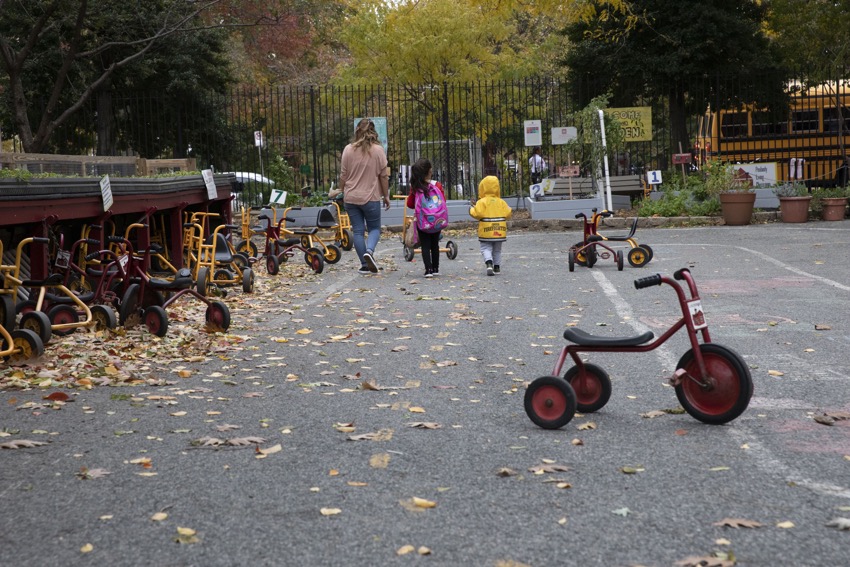Meet the Teacher: 5 Ways to Ease the Transition to School


It’s not very often that life gives you opportunities to truly experience a situation from every perspective. This past week afforded me such an opportunity: “Meet the Teacher.”
Throughout my childhood and then as a teacher, I experienced decades upon decades of “Meet the Teacher” events. I always marveled at how similarly I navigated them from my earliest childhood memories to my last year of teaching six years ago—excited, a bit nervous, and usually rocking a new pair of shoes.
Well, this past Wednesday, I experienced my first-ever “Meet the Teacher” as a parent, and my decades of experience navigating these events did NOTHING to prepare me for what it felt like as a mom. I now know firsthand how equally a child’s grown-up is looking for that welcoming smile when we walk in the door and hoping our children will feel loved and accepted from their very first moments in the classroom.
Children and teachers spend time together nurturing their relationship and building trust over those first critical weeks of the year as a classroom community is created, expectations are explored and explained, routines are established, and one-on-one interactions lay the foundation for the rest of the year. Each day, a child feels a little more comfortable and perhaps even excited to go to school. Each day, the teacher feels more and more confident in her role and in her ability to individualize her approach for each child as she learns about their individual needs.
But as a mom, I don’t get all that “together” time. Sure, I did my research to find what I thought was the best preschool fit my daughter, I went on a site visit last winter to see the school in action, but then BOOM! come the first week of September, here I am getting ready to leave the most precious thing in the world to me with a group of adults that I honestly know very little about. I need to know that someone will notice when she’s feeling nervous and put a reassuring palm on her back to let her know she’s okay. I need to know that someone will help her with her new water bottle because sometimes she gets flustered with opening the spout; that someone will know when she needs a confirming nod that she can tell a peer that she wasn’t finished using that crayon when he snatched it from her hand. I need to trust that I’ve done everything I was supposed to do to give her the confidence to weather this transition. It’s a lot. I’m not sure that I’ve ever felt so vulnerable as a mom. And I have the benefit as a former teacher of knowing in my heart that of course the teacher is looking out for those things and even more. What I didn’t realize when I was a teacher was how much parents also needed those reassuring nods and confirmation that “we’ve got this.”
You can ease the transition for families.
Here is a handful of strategies you can use during the beginning of the year to help facilitate the transition to school for children and their families.
- Send a newsletter home—ideally a week before school starts—to introduce yourself to children and their families. Consider including a picture of you and your co-teacher in the classroom so children will know what you look like. The newsletter can foster family conversations about school in general and about you as a teacher. Consider also sharing some interesting facts about you. What are your favorite things to do in the classroom? Is there a children’s book that you love that children may also have at home? What hobbies do you enjoy?
- Plan a playground visit for children and their families, teachers, and school staff on a weekend at the school playground or a local park, either before school or early in the year. This affords children the opportunity to engage in familiar experiences with new peers, climb the ladder, slide down the slide, dig in the mulch, and possibly spark some connections with people who will become familiar and comforting faces in the classroom. A playground visit also provides opportunities for families to meet and to gain confidence as they see you warmly engage and play with their children, facilitating peer interactions and fun.
- Plan a home visit in the first few weeks. For most children, it’s in their home environment where you will see their most authentic and comfortable self. The experience of a family welcoming you into their home for a brief visit where you can meet siblings and the family pet, play with the child’s favorite toys, talk about interests, and share some insight into the exciting things that will happen at school can go a long way toward building the trust not only between you and the child, but also between you and the family members. It sends a clear message to all parties that there is a strong connection between home and school.
- Allow sufficient time for hellos and good-byes. At the start of the year, some children will have difficulty with separation. Make transitions from home to school easier by encouraging family members to stay for a few minutes and help children begin activities. Reminders of home can also be helpful: invite children to bring along a comfort item such as a stuffed animal or blanket or have family members record a favorite story, poem, or song for children to listen to later.
- Post photos of families at children’s eye-level in the room. This way, when a child is having feelings of homesickness, you can take her hand, walk over to her family photo, and ask her to tell you a bit more about the people in her family and offer a reminder of how excited dad will be to pick her up after you come back inside from playing on the playground.

Informed Intentionality: A Back-to-School Webinar Series for Early Childhood Educators
Throughout this four-part webinar series, we will look at what’s essential in an early childhood classroom, what’s nice to include if time and resources allow, and what you don’t need to worry about at all.